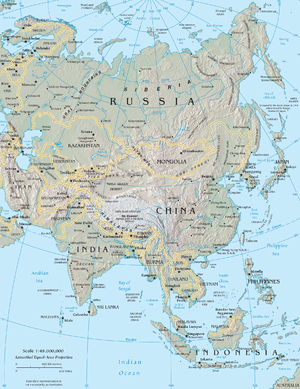 Image via Wikipedia
Image via WikipediaBudget Crises Spread
A rising irritation with public employee unions is palpable, as a wounded economy has blown gaping holes in state, city and town budgets, and revealed that some public pension funds dangle perilously close to bankruptcy.
 Image via WikipediaA new regime in state politics is venting frustration less at Goldman Sachs executives (Governor Christie vetoed a proposed “millionaire’s tax” this year) than at unions. Newark recently laid off police officers after they refused to accept cuts, and Camden has threatened to lay off half of its officers in January.
Image via WikipediaA new regime in state politics is venting frustration less at Goldman Sachs executives (Governor Christie vetoed a proposed “millionaire’s tax” this year) than at unions. Newark recently laid off police officers after they refused to accept cuts, and Camden has threatened to lay off half of its officers in January.
This battle comes woven with complications. Across the nation in the last two years, public workers have experienced furloughs and pay cuts. Local governments shed 212,000 jobs last year.
( Shit rolls downhill. Blame the uninvolved. Sounds like "7 Stages of a Project " in reverse.
Phase 1: Uncritical Acceptance
Phase 2: Wild enthusiasm
Phase 3: Dejected disillusionment
Phase 4: Total confusion Image via Wikipedia
Image via Wikipedia
Phase 5: Search for the guilty
Phase 6: Punishment of the innocent
Phase 7: Promotion of nonparticipants )
Heinrich von Kleist: The military is "a living monument to tyranny"
10 Modern Methods of Mind Control
There is a coordinated script that has been in place for a very long time with the goal to turn the human ra Image via Wikipediace into non-thinking automatons. For as long as man has pursued power over the masses, mind control has been orchestrated by those who study human behavior in order to bend large populations to the will of a small "elite" group. Today, we have entered a perilous phase where mind control has taken on a physical, scientific dimension that threatens to become a permanent state if we do not become aware of the tools at the disposal of the technocratic dictatorship unfolding on a worldwide scale.
Image via Wikipediace into non-thinking automatons. For as long as man has pursued power over the masses, mind control has been orchestrated by those who study human behavior in order to bend large populations to the will of a small "elite" group. Today, we have entered a perilous phase where mind control has taken on a physical, scientific dimension that threatens to become a permanent state if we do not become aware of the tools at the disposal of the technocratic dictatorship unfolding on a worldwide scale.
Unable to die until hell of war can be told
- Asahi Shimbun Company >
- Asia Network
- The Asahi Shimbun Asia Network (AAN) is a think tank that aims to promote information and human exchange in Asia. One of its major activities is to organize a network of scholars, researchers and journalists who exchange their ideas on pressing themes that are indispensable for mutual understanding in Asia, including annual international symposia. The AAN also invites young to mid-career reporters from major Asian newspapers to Japan and supports them in their Japanese studies and reporting activities.
-
 Latest articles by AAN researchers
Latest articles by AAN researchers- International Resource Recycling: Rare Metal Salvage in Asia Kojima Michikazu, Director, Environment and Natural Resource Study Group, Institute of Developing Economies-Japan External Trade Organization (2010/12/17)new
- Japan and India: Catch-up Time for Public and Private Kondo Masanori, Senior Associate Professor of Economics, International Christian University, Japan (2010/12/09)
- Seizure of Chinese Trawler: Japan and China should think beyond logic of sovereignty Amako Satoshi, professor of modern China studies, Waseda University (2010/10/05)
- Japan and Korea: It’s Time to Take Advantage of Each Other Strategically Kimiya Tadashi, associate professor of modern Korean politics, University of Tokyo (2010/09/08)
- DPJ Foreign Policy: Toward Security Dialogue with Asia Soeya Yoshihide, director, Keio Institute of East Asian Studies, professor of international politics and Japanese foreign policy, Keio University (2010/08/23)
- Condemn but Converse: A Japan-U.S.-R.O.K. Response to North Korea Izumi Hajime, professor of East Asian International Politics, University of Shizuoka (2010/07/08)
- Environment and Development: Risks of Overemphasis on CO2 Reduction Inoue Makoto, professor, the University of Tokyo (forest sociology & governance) (2010/06/02)
 Image via Wikipedia
Image via Wikipedia - East Asia as a Community that Confirms Diversity by Ogura Kizo, associate professor, Kyoto University Graduate School (Korean philosophy) (2010/05/18)
- The Perils of Modernization-Theory Amnesia: A Centennial to Remember for Korea and Japan by Cho Kyeungdal, professor of Korean history and the history of Japan-Korea relations, Chiba University (2010/04/01)
- East Asia’s Shared Writing System: The Cultural DNA That Binds by Wang Min, professor of culture and Japanese studies, Hosei University (2010/03/03)
- Diversity and Change in China: Freedom of Speech in Beijing by Motoaki TAKAHARA, Japan Society for the Promotion of Science Research Fellow(Visiting Researcher at the Chinese Academy of Social Sciences) (2010/02/05)
- China-Japan-Korea International Symposium:More Heat Over Social Issues than Politics Ryosei KOKUBUN, Dean, Faculty of Law, Keio University (2009/12/17)
- Raising the Banner Against Nuclear Arms: Hatoyama Administration Should Take a Firm Stand By Takao TAKAHARA, Professor of international politics and peace research, Meiji Gakuin University (2009/11/26)
- The Smart Approach to Asserting Japan’s Presence in Asia By Yoshiharu Tsuboi, Professor of the History of Southeast Asian Politics and Society, Waseda University (2009/10/15)
- Japan's Stance on North Korea Should Clarify Objectives of "Dual Sanctions" By Masao Okonogi, Professor of Political Science, Director of the Graduate School of Law and Political Science, Keio University (2009/09/17)
- Manifestoes: Japan’s Political Debates Need a Broader Perspective By Park Cheol-hee, Associate Professor, Contemporary Japanese Politics, Graduate School, Seoul National
 Image via WikipediaUniversity (2009/08/06)
Image via WikipediaUniversity (2009/08/06) - Efforts to Forge Closer Links Needed Instead of ‘Soft Power’ Rivalry By Shigeto Sonoda, Professor of Comparative Sociology of Asia, Graduate School of Interdisciplinary Information Studies, University of Tokyo (2009/07/23)
- Post-election India -- With Domestic Stability Assured, Asian Giant Looks to Expand Its Global Presence By Takako Hirose, Professor of South Asian Politics, Senshu University (2009/06/18)
- Arms Embargo Treaty Needed for Conflict-Torn Africa By Noboru Hatakeyama, Chairman, the Japan Economic Foundation, and former vice-minister for international affairs, Ministry of Economy, Trade and Industry (2009/05/28)
- Environmental Business in China -- Japan Should not stick to Intellectual Property Protection By Nobuhiro Horii, Associate Professor, China Industry Analysis, Kyushu University (2009/05/21)
- Politics at a Crossroads --- What are the choices for voters in the fast-approaching general election? By Kiichi Fujiwara, professor of international politics at the University of Tokyo (2009/04/16)
- Global Fight against Marine Piracy Should Learn from Malacca Model By Isami Takeda, Professor of International Relations at Dokkyo University (2009/03/16)
 Image via WikipediaPfizer tested drugs on children
Image via WikipediaPfizer tested drugs on children
Afghanistan, Colombia, Vietnam: The Deep Politics of Drugs and Oil
Since World War Two, the United States has had in effect two conflicting styles of conducting foreign policy, one for other developed states, and a quite different style for regions of little economic interest apart from their mineral resources " above all oil and natural gas.
As a general rule, the US has worked through the established governments of developed states. But in Third World areas and regions with oil or other minerals, the US has done whatever it thought necessary to secure access when it wished to do so. As Michael Tanzer observed some years ago, a number of CIA-engineered coups in the 1950s and 1960s, starting with Iran in 1953, can be related to the intentions of those countries to nationalize their oil companies.
Most Popular Articles
in the Last 2 Days
(by Page Views)
in the Last 2 Days
(by Page Views)
Rove Might Be Trying To "Pull A Siegelman" With Julian Assange by Roger Shuler
Capricorn Solar Eclipse, January 4, 2011 by Cathy Lynn Pagano
How to Detect and Avoid the Top Scam Money Making Websites by Annabelle Charbit
Reasons why Bradley Manning's alleged Crimes are Serious and deserve Harsh Punishment by Steven Leser
Top NASA astronaut discloses shuttle encounter with disc UFO by Terrence Aym
Oil is Not Food but Food is Oil: The Imminent Crisis of Food Production Dependence on Oil by David Model
Haiti's Elections: Illegitimately Recounting Fraud by Stephen Lendman
Is an economic collapse being prepared? If so, for whose benefit? by Richard Clark
The Anti-Empire Report Wikileaks, the United States, Sweden, and Devil's Island by William Blum
There are no words.
With Sergeant Senft, the warning signs were obvious, and he had already attemted suicide twice since his most recent deployment while he was stateside at Ft. Campbell, He had even been an inpatient at a mental health facility after the latest attempt. Yet the Army declared him fit for duty and sent him to Afghanistan anyway. Once there, his chain of command was so concerned that they disarmed him and sent him to counseling -- yet he was assigned to share quarters with a roommate who was fully armed.The bullet he put in his head came from his roommate's M-4.
Cross Purposes
There hasn't been a single word uttered on any of the Sunday morning shows or nightly newscasts about the fact that what is really at stake in Kashmir is water.General Kayani, the commander of the Pakistani Army, views the Haqqani network of militants as a buffer between his nation and India
The United States military is providing the security for Chinese road-building crews to construct roadways to the vast mineral resources that they won the contracts to mine
Kayani's long view runs counter to the more immediate viewpoint of the Americans and NATO, and this leaves impatient American commanders saying "fuck it" and ordering another drone strike, even though blowing shit up does not a foreign policy make.
The other Kashmir problem: India and Pakistan tussle over water
Water disputes have joined territorial disputes as a flashpoint between India and Pakistan, which both control parts of the Kashmir region. As both countries race to build a dam there, they could fight hard for control of the major rivers.
Mountains of Concrete: Dam Building in the Himalayas
There will always be abundant snow and glaciers on the highest mountains of the world, the Himalayas. This snow will always feed the Indus and Ganges rivers and forever supply water to millions of people in South Asia and China.These statements may no longer be true. Our warming climate is changing the Himalayas faster than any other region of the world. The mountains’ mighty glaciers, the source of most large Asian rivers, are melting.
Against these dramatic changes, the governments of India, Pakistan, Nepal and Bhutan are planning to transform the Himalayan rivers into the powerhouse of South Asia. They want to build hundreds of mega-dams to generate electricity from the wild waters of the Himalayas.
 |
Mountains of Concrete by Shripad Dharmadhikary, one of South Asia’s foremost water and energy experts, discusses for the first time the linkages between climate change and dam-building in the Himalayas, and comprehensively analyzes the impacts of the dam building spree on the region's people, ecosystems, and economy.
Download the report (pdf)
Himalayan dam boom spells trouble
In early February 2009, Chinese scientists warned that glaciers on the Tibetan plateau are melting at a "worrisome speed," according to Xinhua news agency. Against these dramatic developments, the governments of India, Pakistan, Nepal and Bhutan are planning to transform the Himalayan rivers into the powerhouse of South Asia. They want to build hundreds of mega-dams to generate electricity from the wild waters of the Himalayas.
China's disturbing dam plan
Beijing is embarking on a series of dams and attempts to harness the waters of the Brahmaputra River. One of these alone would be a massive 38-gigawatt project, half as big again as the Three Gorges dam. The Tibetan plateau and the great rivers that rise from it are also part of the ecological heritage of all human beings. The area has been called the Third Pole because of the rich wild resources of the icy plateau. More particularly, more than 2 billion people in south and southeast Asia depend on the vast rivers that flow from Tibet.
The Brahmaputra is of particular interest. Its source is close to the sacred Mount Kailash, and it flows from west to east across southern Tibet before turning north and then making a U-turn at the Great Bend to flow south to India and Bangladesh. The Great Bend is known as "the last secret place on earth" with a rich ecosystem and biological diversity — as well as having the greatest potential for hydropower of any place on Earth. At the Great Bend the river goes through a gorge between two 7,000- meter mountains and then drops almost 2,500 meters as it makes the bend.
The difficulties are compounded because China has been economical with information about what it is doing in Tibet.Information is available on Chinese activity and ambitions concerning the Brahmaputra, and they are more than scary. Zhang Boting, the deputy secretary general of the China Society for Hydropower Engineering, told Britain's Guardian newspaper in May that a massive dam on the great bend of the Yarlung- Tsangpo would benefit the world. The official claimed that research had been done, but no plans drawn up for a project.
This seems to be an understatement. Tashi Tsering, who is a Tibetan scholar at the University of British Columbia, lists almost 30 dams on the Yarlung-Tsangpo- Brahmaputra that are planned, under construction or being actively discussed, including a 38-gigawatt project at Motuo and another bigger one at Daduqia (see tibetanplateaublogspot.com). The latter is still a proposal and is probably too close to the Indian border to be attractive, but the Motuo project is likely to go ahead, thinks Tsering.
Mountains of concrete?
When planning hydropower projects, some of the most crucial data is about river flow. However, with melting glaciers in the Himalayas, historical river flows are no longer a good measure for future flows. Climate change has destroyed the certainty that future river flows will be similar to past flows.
This uncertainty makes it incredibly risky to build dams. The extent of the predicted storms is not known, the seasonal distribution of waters is no longer certain. Nobody can predict when the waters in the rivers will rise, how much they will rise and for how long. Moreover, no one knows when the glaciers will eventually have melted – and no longer can provide any water to the rivers at all. We only know that the melting of the glaciers in the Himalayas will result in an initial increase and then a decline of water flows in the Himalayan rivers. The data needed to build hydropower projects in the Himalayas is not available. It is not clear how often the dam gates of any planned dam in the Himalayas will have to be left open in order to allow for extremely high floods to rush through its gates (all the while not generating any power). Storms, strong rains and floods, which are predicted to increase with the warming climate, can also threaten the very existence of dam walls and can destroy even the most robust mountains of concrete planned in the Himalayas.
The data needed to build hydropower projects in the Himalayas is not available. It is not clear how often the dam gates of any planned dam in the Himalayas will have to be left open in order to allow for extremely high floods to rush through its gates (all the while not generating any power). Storms, strong rains and floods, which are predicted to increase with the warming climate, can also threaten the very existence of dam walls and can destroy even the most robust mountains of concrete planned in the Himalayas. Shripad Dharmadhikary, in his report “Mountains of Concrete: Dam Building in the Himalayas” , has shown that the plans for most dams in the Himalayan region do not take the likely impacts of climate change on the Himalayan rivers into account. Dharmadhikary says: “Unfortunately, none of these risks are being considered in the dams planned for the Himalayas – neither for individual dams, nor cumulatively”.









No comments:
Post a Comment